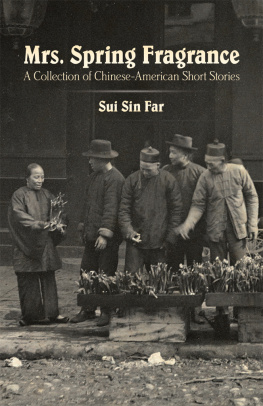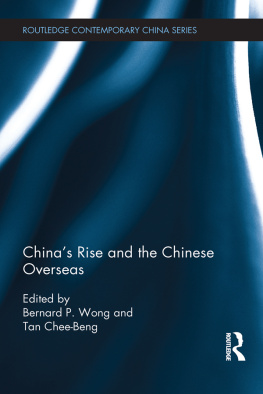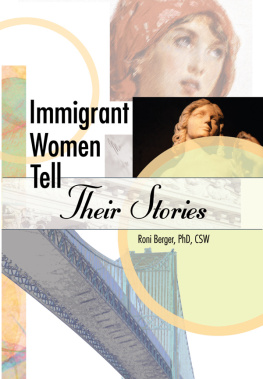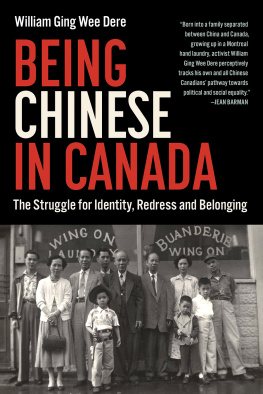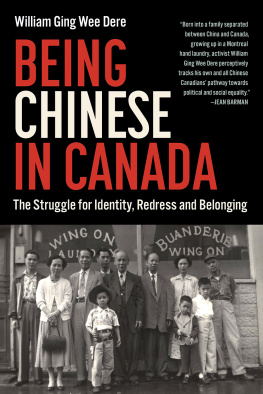Passage
to
Promise
Land
Passage
to
Promise
Land
Voices of Chinese Immigrant Women to Canada
VIVIENNE POY
McGill-Queens University Press
Montreal & Kingston London Ithaca
Vivienne Poy 2013
ISBN 978-0-7735-4149-8
Legal deposit second quarter 2013
Bibliothque nationale du Qubec
Printed in Canada on acid-free paper that is 100% ancient forest free (100% post-consumer recycled), processed chlorine free
McGill-Queens University Press acknowledges the support of the Canada Council for the Arts for our publishing program. We also acknowledge the financial support of the Government of Canada through the Canada Book Fund for our publishing activities.
Library and Archives Canada Cataloguing in Publication
Poy, Vivienne, 1941
Passage to promise land : voices of Chinese immigrant
women to Canada / Vivienne Poy.
Includes bibliographical references and index.
ISBN 978-0-7735-4149-8
1. Chinese Canadian womenInterviews. 2. Chinese Canadian womenSocial conditions20th century. 3. Women immigrantsCanadaInterviews. 4. Women immigrantsCanadaSocial conditions20th century. I. Title.
FC106.C5P69 2013 305.48'4120971 C2012-908373-9
This book was designed and typeset by studio oneonone
in Minion 10.6/14
This book is dedicated to all
Chinese immigrant women in Canada
Contents
Preface
This volume might be described as a panorama of the twentieth century on two sides of the world. Canada went through two world wars and developed from a narrowly Eurocentred semi-colonial outpost into a nation that embraced a multicultural identity and gained respect for its independent foreign policy and initiatives in peacekeeping. China went through those same world wars, followed by a Communist revolution in 1949 and thirty years of political movements that led to great suffering for many of its citizens. Following Deng Xiaopings accession to power in 1978 and the decision to open up to modernization, the world and the future, Chinas economic progress changed the face of the nation and its role in the world. The tiny outpost of Hong Kong on the South China coast, a British colony from 1842 to 1997 and a dynamic city, also changed dramatically over the twentieth century. Its role as a way station for refugees from China who found their way to Canada in the years after the Second World War, along with the special relationship it developed with Canada in the years leading up to its return to China in 1997, give it a prominent place in the unfolding story.
The focus on Chinese women who moved between China, Hong Kong, and Canada gives this story its unique character, providing unusual insights into the historical change process. Their lives were often caught up in restrictions imposed by Chinas patriarchal traditions and in disadvantages arising from discrimination and bias in Canadian immigration policy. Nevertheless, they exerted a remarkable degree of agency in the decisions they made and in their contributions to Promise Land, the name given to their newly adopted country in the early years. The framework drawn from feminist analysis and understanding is introduced delicately, non-dogmatically, and in ways that shed new light on many well-known junctures in Canadian history.
In chapters 2 to 9 of this volume, we are treated to the vivid narratives of twenty-eight women who emigrated to Canada between 1950 and 1989 years of political, economic, and social change in China, Hong Kong, and Canada. They tell the stories of their childhood in China or Hong Kong and the conditions that led to their immigration to Canada. This was largely a matter of family reunion or pre-arranged marriage in the early years; later, higher education became a main attraction, and ultimately it was the diverse professional and business opportunities that opened up. For most of these women, the opportunity to tell their stories was welcomed, and in some cases they felt it had been a healing and affirming experience. Follow-up interviews with many of them in 2010 has enabled us to observe their progress into the first decade of the twenty-first century.
Chapter 1 provides a historical background that explains the highly discriminatory immigration policies that had barred entry to Chinese women, with a few exceptions, up to the late 1940s. The role of the early immigrants, including such outstanding activists and political organizers as Jean Lumb and Douglas Jung, in demanding equal citizenship rights and fair immigration policies, gradually led to a more equitable playing field. Finally, Hong Kongs prosperity and Canadas policies of encouraging an investor category of immigration created a situation that was favourable to Chinese immigrants, and the stories of professional women and business leaders coming in this later period are riveting. Sadly, it did not mean the end of discrimination, since new causes for social prejudice arose from an envy inspired by the educational and economic success of many Chinese Canadians. Chapter 10 ties all the threads of the stories together in a thoughtful analysis of the interconnected historical causes lying behind the dramatic changes that unfolded between the 1950s and the first decade of the twenty-first century.
Generally, this is an uplifting story, with compelling evidence of the greatly increased agency and possibility for Chinese women over the decades, and a remarkable degree of agreement among those interviewed that their lives had been transformed in positive ways by the opportunity to settle in Canada. By the same token, they have made remarkable contributions to Canadian society as teachers, university administrators, artists, community organizer, and multinational businesswomen. All of this, of course, rested on their equally important roles as homemakers and as the heart and soul of Chinese Canadian communities. In some cases, Chinese women have excelled in important social and political leadership roles, reflecting the increasingly prominent role women have played in Hong Kongs social history.
Nevertheless, readers should not view this as a book narrowly focused on the experience of Chinese women. Rather, it is a breathtaking overview of Canadian history seen from the perspective of women immigrants who have contributed in important ways to that history. A rich array of historical sources, from scholarly texts to archival material, newspapers, and the records of parliamentary debates, have been drawn upon to give a critical account of changing immigration policies over more than a century. Given the importance of immigration in Canadas history and the composition of the Canadian population, it is also a book about Canadian identity. Insightful analysis is given into the interconnection between the reform of immigration policy and Canadas efforts to improve its international image in the 1960s. The slow unfolding of a policy of multiculturalism is also presented, beginning in the early 1970s and culminating in the passage of the Multiculturalism Act of 1988. There is further analysis of how Canada has navigated the difficult waters of globalization since the end of the Cold War in 1991 and how it has benefited from the input of a privileged and mobile international capitalist class of people.
Most of all, this is a very human book connecting readers to successive generations of immigrants, their parents and grandparents, their children and grandchildren, their joys, anxieties, efforts, and achievements. It is a book that calls upon readers to interrogate themselves and reflect on where they have been over these years and how they have contributed to, or possibly resisted, the social transformations that are described. It is also a book that calls for much comparative reflection across different time periods and among different groups of immigrants and citizens in Canadas cultural mosaic.


